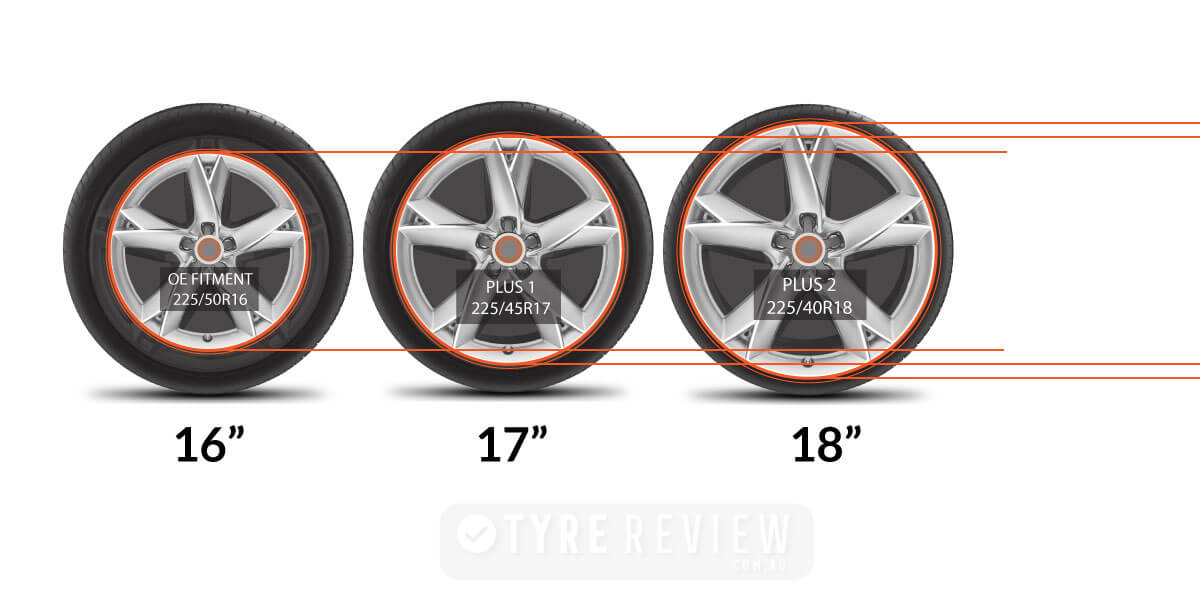Tyre Plus Sizing
In order to properly understand plus sizing it is important to understand some of the terminology used:
- Wheel or Rim Diameter: This is the diameter of the wheel or rim, not including the tyre. Usually measured in inches, modern vehicles usually have rims ranging from 16” to 20”. Although some high performance or modified vehicles can have rim diameters in excess of 20”. For a detailed description of how to identify your rim size please click here.
- Overall Rolling Diameter: This is the outside diameter of the tyre, while it is fitted to the chosen rim. This measurement is usually given in millimetres and can be calculated by adding the diameter of the rim to the sidewall height of the tyre. Sidewall height is also known as sidewall aspect ratio, profile or series. For a detailed description of how to calculate this value please click here.
The most basic description of tyre plus sizing is that the diameter of the rim is increased while at the same time the tyre’s sidewall height is decreased. The end result is that the overall rolling diameter of the tyre is not changed.
The main advantages of plus sizing are as follows:
- A larger rim with a lower sidewall profile tyre will provide better handling, with increased steering and braking response. The reason being that the smaller sidewall is stiffer, which gives the driver a more direct feeling of control over the vehicle rather than the more spongy feel of a large sidewall profile tyre.
- The larger rim will enhance the look of the vehicle, giving it a more aggressive stance. You will notice that most modern performance vehicles have large rims with low sidewall profile tyres.
If you take a look at our picture below you can see how the principle is implemented. In our example the manufacturer’s original equipment rim was 16” with a 225/50R16 tyre. With a plus 1 size the rim increases to 17”, while the tyre’s sidewall aspect decreases to 45. The end result being that the overall rolling diameter is unchanged. Taking the principle one step further, with a Plus 2 sizing the rim increases further to 18” with the sidewall aspect decreasing further to 40. Again the end result is that the overall diameter is unchanged.

Maintaining the same overall rolling diameter is the key to plus sizing and is very important for the following reasons:
- Speedometer accuracy: Your speedometer is calibrated to suit the manufacturers overall rolling diameter. If this is changed your speedo will no longer be accurate.
- Traction Control, Stability Control and ABS: These sophisticated electronic systems are also calibrated to suit the vehicle’s original overall rolling diameter. These systems can be very precise and even a small change in overall diameter may alter their functionality.
- Interference: Clearances can already be quite tight on some vehicles and a change in overall rolling diameter or tyre width may lead to the tyre touching the wheel arches, the body of the car or suspension and brake components. This interference can be dangerous and will definitely damage your tyres.
Are there any disadvantages of plus sizing? There is really only one effect of plus sizing which may be undesirable. If your vehicle is more of a people mover or you do a lot of driving then ride comfort may be important to you. With a plus size fitting you may feel the bumps and pot holes in the road more harshly due to the lower, stiffer sidewall of the tyre.
PRESSURE TEST: DRIVING ON SANDAT OR MT TYRES ON SAND, WHICH IS BEST?Which type of 4WD tyre should I get?Tyre DeflatorsHow to Drive in the Snow - We asked an expert!4wd Air pressure
When do I need new tyres?What should my tyre pressure be?How can I tell what size my Tyres are?Where is my vehicle placard?Wheel Balancing: What It Is and When Your Car Needs ItWheel BalancingSpace Saver vs Full Size Spare TyresOverloading your 4x4 - it’s easier than you think..Vehicle Inspection Schemes across Australia.What should I do if I get a flat tyre while driving?How a tyre's tread pattern deals with waterAquaplaningMaterials used to construct a tyre
What should my tyre pressure be?The Effects of Over or Under Inflated TyresIs filling your tyres with Nitrogen worth it?Advantages of Correct Inflation PressureHow often to check Tyre PressuresNitrogen in tyres
